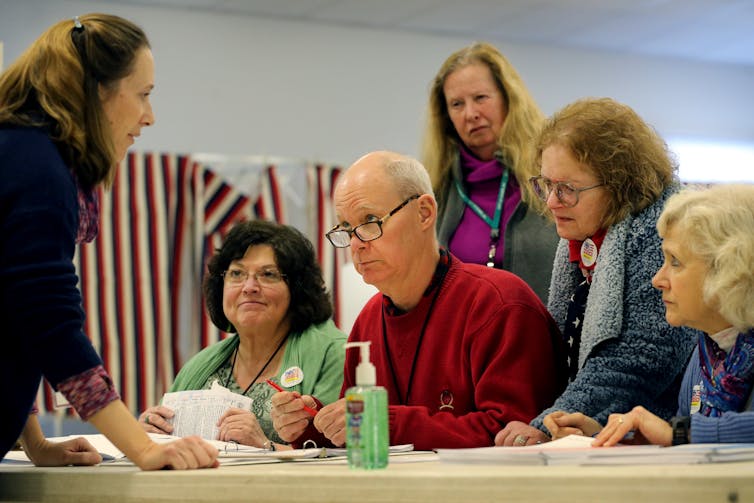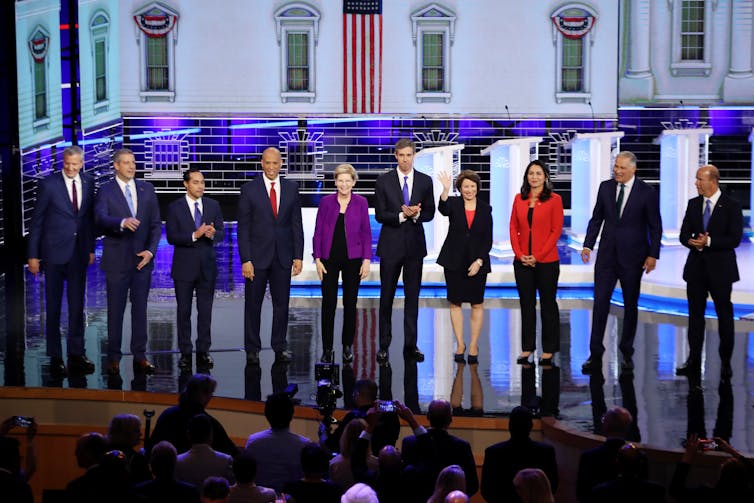Democrats aim to design a presidential nomination process that gives everyone a voice – and produces a winning candidate

This piece originally appeared on The Conversation, which AllSides rates as Lean Left. It was written by Barbara A. Trish, an Professor of Political Science at Grinnell College The writer's bias has not been rated.
For the past few election cycles, the quartet of Iowa, New Hampshire, Nevada and South Carolina has had a lock on the early spots in the Democratic Party’s presidential nomination process.
But that may be about to change.
Like clockwork every four years, Democrats hunker down to tweak their rules for presidential nomination, and right now they’re finely tuning the 2024 calendar. The party has routinely pinned its hopes on nomination rules to pave the way for a November win.
As a longtime scholar of the presidential nomination process, I have observed that the rules battles aim to find that sweet spot that is likely to churn out a nominee with broad appeal both within the party and outside of it.
The party needs to balance the legitimacy that comes with a process making it easy for average Democrats to insert their voices with the safety valve that lets savvy party insiders weigh in on the selection. All those pieces must produce a process long enough to ensure real competition, but not so long that internal party fences can’t be mended well in advance of the general election.
This time around, the Democratic National Committee is targeting that mix of states that will start the nomination process, hoping for something better than what’s been in place. It’s taken the unusual step of setting up a competition among state parties to help it set the 2024 calendar. Sixteen states and Puerto Rico just made their pitches to the national party to be among the first to hold contests, with a decision expected later this summer.
It’s tempting to flag this all as a ploy to dislodge the Iowa caucuses from their leadoff role, a position they’ve held since 1972. In fact, Iowa’s claim on that privileged position is very much at risk, especially given its 2020 caucus counting fiasco, which I detail in my book, “Inside the Bubble.”
Going early matters because it gives Democrats in those states a larger voice in the nomination. Candidates flock to the early states, interacting with voters and sometimes tailoring their policy appeals to the needs unique to a state. The first contests don’t determine who will win, but they typically knock some candidates out of the running.

Election workers at the Elks lodge, Ward 4, in Dover, N.H., on Feb. 11, 2020, when the New Hampshire primary was held. Craig F. Walker/The Boston Globe via Getty Images
The two major U.S. parties are federal in nature, their organizational structures reflecting the array of elective offices for which they compete, from county sheriff to the president. Even so, the national party is well positioned to call the shots at the state level, shored up by a now decadesold Supreme Court decision establishing the national party’s superiority over state parties.
The national committee has kept control over the calendar for a long time, starting down that path when it overhauled nomination rules after the contentious 1968 Democratic national convention. The package of reforms, implemented first in 1972, sought to take presidential nominations out of the proverbial back room and make them more open, more democratic.
Technically, at the primaries and caucuses, voters select the delegates who support the presidential candidate they favor. At the party convention, the candidate with the majority of delegates wins the nomination.
Before the 1972 reforms, delegate selection wasn’t always tied to outcomes in primaries and caucuses. According to nomination expert Elaine Kamarck, 25% of 1968’s presidential delegates were selected in 1967, well before what’s now considered the formal start of the nomination race.
Under the initial terms of the 1972 reforms, the national party didn’t limit how early in the election year a state could hold its nomination contest. That Iowa went first in 1972, though, was not so much a deliberate move for positioning as an unintentional byproduct of another national party rule.
The reformed system, in the interest of allowing time to publicize contests, required 30 days’ notice of delegate selection contests. That meant Iowa had to start early, since the state’s process involved a series of contests, not just the prominent precinct caucuses. But Iowa started even earlier than dictated by the new rules, essentially because of a fluke involving high demand on hotel rooms.
By 1980, Iowa had secured its role as the first caucus and New Hampshire was designated as the first primary. For that election cycle, the Democratic National Committee imposed a rule condensing nomination contests into a 13-week window, beginning in early March. But then-President Jimmy Carter, seeking reelection and with sway over his party, pushed for an exception for Iowa and New Hampshire, states that had jump-started his 1976 campaign and might serve as a firewall. The national committee ultimately granted the exception.
Back in the 1970s, the Democratic National Committee had no beef with caucuses, and more states held caucuses than primaries. They were seen as settings for deliberation and activist engagement.
But in 2022, caucuses are under fire for being exclusionary, and most states hold primaries. The switch from caucuses to primaries in the 1970s and 1980s was largely an unanticipated consequence of the initial reform, because complying with those new rules from 1972 was easier with primaries than caucuses. In 2020, the Democratic National Committee pushed states to expand the use of primaries, asserting that they are more inclusive, transparent and accessible than caucuses.

Caucuses and primaries aim to winnow down large fields of candidates. These 10 Democrats were only half of the field when this debate was held on June 26, 2019, in Miami. Joe Raedle/Getty Images
The irony is that in moving to a primary, a party relinquishes power.
Caucuses are party-run and party-financed events, while primaries are state-run party elections. In an era dominated by Republican-controlled state legislatures, some of which have passed restrictive voting laws, Democratic primary states put themselves at the mercy of the opposition party.
This summer’s actions by the Democratic National Committee could shake up the 2024 calendar. Iowa’s at risk of losing its privileged position, but so far the committee hasn’t guaranteed any state an exception to the 13-week window. The committee says that up to five states will be able to hold contests before the window begins. The other three traditional early-goers, I believe, are positioned a little better than Iowa to nab one of the early slots.
There’s no reason to think that White House pressure would prevail as it has in the past, but if so, the “gut punch” Iowa delivered to then-candidate Biden in 2020 and his “resurrection” in South Carolina would likely carry weight in the deliberations.
Iowa Democrats submitted their proposal to the Democratic National Committee in early June 2022, describing a process that retains the caucus label yet complies with stated committee criteria of fairness, transparency and inclusivity. Notably, Iowa’s new plan provides for a period for participants to express presidential preferences before the actual caucuses, meaning there would be a way for voters to participate without attending the caucuses. This would make the process a little more inclusive.
A final decision on which states will be able to hold early contests is expected from the Democratic National Committee in early September.
Whatever the shape of the new calendar, it’s a safe bet that things won’t play out precisely as planned, given that unanticipated consequences have marked the party’s reform efforts in the past.![]()
Barbara A. Trish, Professor of Political Science, Grinnell College
This article is republished from The Conversation under a Creative Commons license. Read the original article.

April 18th, 2024

April 17th, 2024

April 17th, 2024

April 16th, 2024